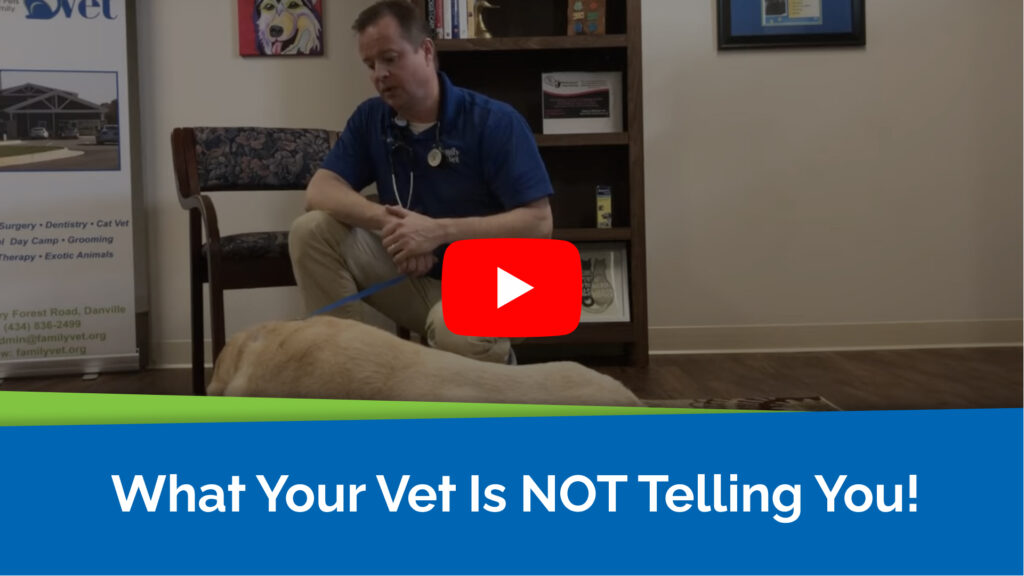Pet Physical Exams in Danville, VA
What typically happens when go to a veterinary appointment? You check in at the front desk and someone comes up to bring you in a room and ask you a few questions. Then the vet comes in and talks to you for a little bit, rubs your pet and then come to the dreaded shots! Is this how a good pet physical exam should go for your furry friend?
Well, actually, there is a lot more to it than that. A good vet visit is a team effort and begins with the “history.” The history is what has been happening with your pet, what has changed, what seems to be wrong. This may include changes in daily routine, new habits or quirks. The veterinarian and his team will ask you a number of questions some of which are simply curiosity and caring, but many of the questions are directly pointed at narrowing down the problem. This is often what the veterinary team is not telling you. By not fully including you in the process, I think our profession is making a huge mistake. After all, you know your pet better than anyone else and you have many of the answers already.

I once saw a cat lover who had a cat that was urinating in the bathroom sink. Now, that’s an annoying habit. She came to see me after he had been doing this for about a month. I guess she was being extra careful where she brushed her teeth. Anyhow, we started to explore the history together. It turns out that she had 5 cats and Sam, the problem cat started hiding under the bed when she got her 5th cat 6 months before the incident. Sam had been hiding under the bed and coming out to eat at night. It seems that Sam had been exhibiting signs of stress for quite some time before he developed what turned out to be a urinary tract infection. Sam had a medical problem in the urinary tract infection, a psychological problem in the litter box aversion and inappropriate elimination and a behavioral/social problem in the multi-cat household. Some of the steps of solving the problem together included a physical exam, testing and medications, but a good discussion of the “history” was a huge part of the solution.

So, the history is absolutely essential to a good checkup, but let’s talk about how I perform a physical exam. The first thing I like to do is observe the pet from a distance, this is one of the things your vet is not telling you. They are watching your pet from the first moment they see you. They may be greeting you and your pet and be genuinely glad to see you, and want to love on your pet and hold him, but they are also doing an assessment. They are evaluating signs of stress, neurologic reflexes, musculoskeletal coordination and general health. It is normal for a dog or cat to walk around the room sniffing and investigating everything that is new to them, after 5-10 minutes, they should find a spot and settle down and get comfortable. If they stay on edge or alert longer than this, they are exhibiting signs of stress and anxiety. As they move around the room at their own pace, I can observe their normal gait and determine if there is anything out of the ordinary. Are they fully aware of their surroundings, do they seem to be in pain, do they have trouble with flexibility, etc.?
Depending on the patient, I will do my hands-on physical exam on the exam table or on the floor. (This also depends on if my musculoskeletal system is responding on the particular day. Ha Ha). When I see a new puppy or kitten, I see a cute little fuzz ball that will be somebody’s best friend, but I also see a complex group of biological systems working in sync. It is the systems that your vet is trying to examine, even though she may not be telling you this. Our veterinarians use a systematic approach to evaluate the entire animal from nose to tail. Some of the systems are easy to see such as the skin others are more difficult.
Some of the systems I am evaluating include:
- Muscles
- Bones and Joints
- Nervous System
- Eyes and Ears
- Heart and Circulatory System
- Respiratory – nose, airways, lungs
- Gastrointestinal System – mouth, esophagus, stomach, intestines
- Urinary and Genital
- Lymphatic
- Immune System
- Integumentary System – skin, haircoat, nails
Some of these systems are difficult to see and evaluate without additional help. We use pet blood work such as blood tests, stool and urine tests, and x-rays to help us check the things we cannot see. Dogs and cats age much faster than we do and a team approach is the best way to keep them healthy and happy for the longest period of time so come over for a pet physical exam! These kind of thorough exams will get you ready to our pet boarding and pet grooming services as well. Read our Danville Family Vet reviews.
Schedule an appointment today
We are committed to providing compassionate and effective care to help you, and your pet live your best lives together. You can call us at (434) 836-2499 or visit us at 280 Piney Forest Rd., Danville, VA 24540.
